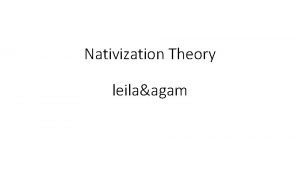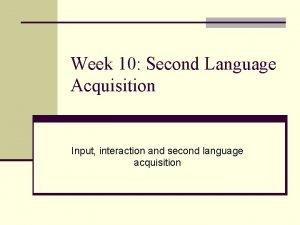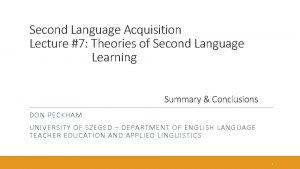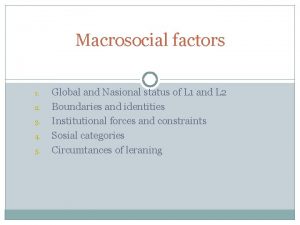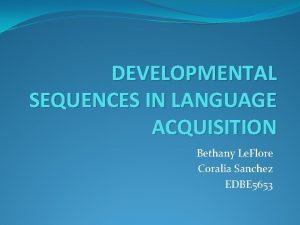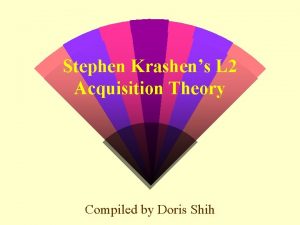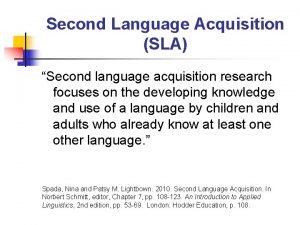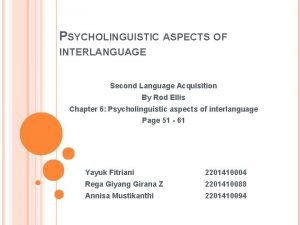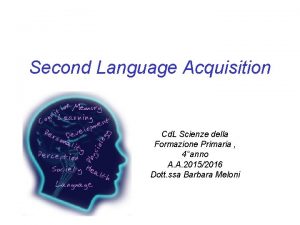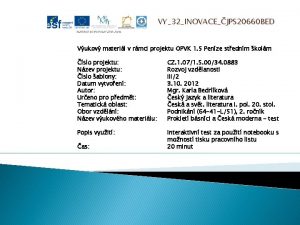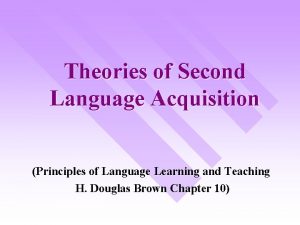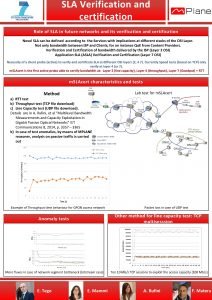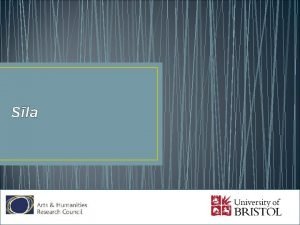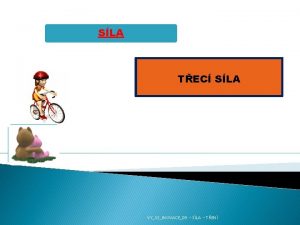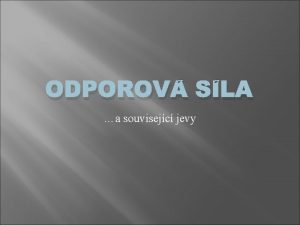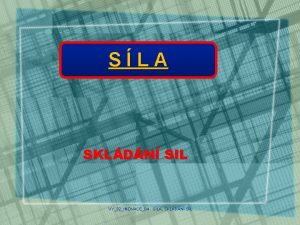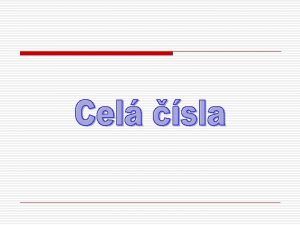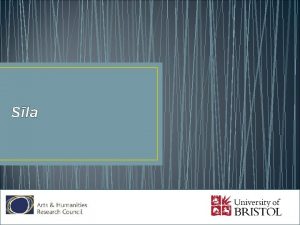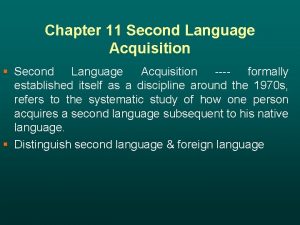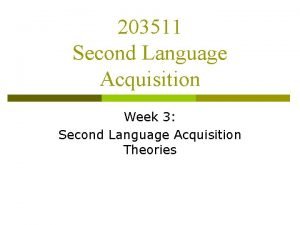Second Language Acquisition SLA Second language acquisition research



















- Slides: 19

Second Language Acquisition (SLA) “Second language acquisition research focuses on the developing knowledge and use of a language by children and adults who already know at least one other language. ” Spada, Nina and Patsy M. Lightbown. 2010. Second Language Acquisition. In Norbert Schmitt, editor, Chapter 7, pp. 108 -123. An Introduction to Applied Linguistics, 2 nd edition, pp. 53 -69. London: Hodder Education, p. 108.

What a Theory Can Do… A (good) theory… n allows us to ORGANIZE what we find / discover. (NOT haphazard) n gives us something to use as a basis for EXPLANATIONS n guides us to ASK certain questions and look for the ANSWERS n SHOULD help us in our TEACHING / LEARNING of languages

SLA Questions What is the nature of language? n How are languages represented in the mind? n How is language processed? n Is learning language same/different from learning anything else? n How are languages learned? n What implications are there for policy makers? Spada, Nina and Patsy M. Lightbown. 2010. Second Language Acquisition. In n Norbert Schmitt, editor, Chapter 7, pp. 108 -123. An Introduction to Applied Linguistics, 2 nd edition, pp. 53 -69. London: Hodder Education, p. 108.

Why do we need to learn about more than one theory? 1. There is NOT JUST ONE, BEST theory. Language is complex. Learning a language is complex. One alone won’t do it. 2. Your personality as a teacher will make certain approaches more appealing to you and you will do better with one theory than another. 3. Students’ learning styles / preferences differ. Mixing and matching approaches / methods / etc provide you the most/best chances to meet student needs.

Theories of Language Acquisition 1 n Linguistic Perspectives n Psychological Perspectives n Sociocultural Perspectives Spada, Nina and Patsy M. Lightbown. 2010. Second Language Acquisition. In Norbert Schmitt, editor, Chapter 7, pp. 108 -123. An Introduction to Applied Linguistics, 2 nd edition, pp. 53 -69. London: Hodder Education, pp. 108, 110, 114.

Theories of Language Acquisition 2 n Linguistic Perspectives Universal Grammar Monitor Theory Spada, Nina and Patsy M. Lightbown. 2010. Second Language Acquisition. In Norbert Schmitt, editor, Chapter 7, pp. 108 -123. An Introduction to Applied Linguistics, 2 nd edition, pp. 53 -69. London: Hodder Education, pp. 108 -110.

Theories of Language Acquisition 3 n Psychological Perspectives Behaviorism Cognitive Psychology Connectionism Processabilty Theory Interactionist Perspectives Spada, Nina and Patsy M. Lightbown. 2010. Second Language Acquisition. In Norbert Schmitt, editor, Chapter 7, pp. 108 -123. An Introduction to Applied Linguistics, 2 nd edition, pp. 53 -69. London: Hodder Education, pp. 110 -114.

Theories of Language Acquisition 4 n Sociocultural Perspectives Spada, Nina and Patsy M. Lightbown. 2010. Second Language Acquisition. In Norbert Schmitt, editor, Chapter 7, pp. 108 -123. An Introduction to Applied Linguistics, 2 nd edition, pp. 53 -69. London: Hodder Education, p. 114.

Observations about L 1 Acquisition 1. Almost all children learn the language around them at about the same time. 2. Even mentally impaired children learn Language. 3. Logical Problem of Language Acquisition a. Language input defective b. Little systematic feedback Spada, Nina and Patsy M. Lightbown. 2010. Second Language Acquisition. In Norbert Schmitt, editor, Chapter 7, pp. 108 -123. An Introduction to Applied Linguistics, 2 nd edition, pp. 53 -69. London: Hodder Education, p. 109.

Krashen’s Monitor Theory Hypotheses 1. Acquisition hypothesis (Learning Acquisition) 2. Monitor hypothesis 3. Natural order hypothesis 4. Comprehensible input hypothesis (i + 1) 5. Affective filter hypothesis Spada, Nina and Patsy M. Lightbown. 2010. Second Language Acquisition. In Norbert Schmitt, editor, Chapter 7, pp. 108 -123. An Introduction to Applied Linguistics, 2 nd edition, pp. 53 -69. London: Hodder Education, p. 110.

Contrastive Analysis Hypothesis n n n If L 1 and L 2 are similar: no problems learning L 2 structure. If L 1 and L 2 are different: yes problems learning L 2 structure. If L 2 had something L 1 did not: yes problems learning L 2 structure. Spada, Nina and Patsy M. Lightbown. 2010. Second Language Acquisition. In Norbert Schmitt, editor, Chapter 7, pp. 108 -123. An Introduction to Applied Linguistics, 2 nd edition, pp. 53 -69. London: Hodder Education, p. 111.

Processability Theory: Pedagogical Conclusions n Teachability Hypothesis n Can't skip a stage n Might be able to encourage (or impede) moving through a stage more rapidly. Spada, Nina and Patsy M. Lightbown. 2010. Second Language Acquisition. In Norbert Schmitt, editor, Chapter 7, pp. 108 -123. An Introduction to Applied Linguistics, 2 nd edition, pp. 53 -69. London: Hodder Education, p. 113.

Learner Language Research Focus n Interlanguage Error Analysis Studies Contrastive Analysis Hypothesis n Developmental Sequences Morpheme Acquisition Studies n L 1 Influence Spada, Nina and Patsy M. Lightbown. 2010. Second Language Acquisition. In Norbert Schmitt, editor, Chapter 7, pp. 108 -123. An Introduction to Applied Linguistics, 2 nd edition, pp. 53 -69. London: Hodder Education, pp. 115 -117.

L 1 Influence “It has been observed that some aspects of language are more susceptible to L 1 influence than others. For example, pronunciation and word order are more likely to show L 1 influence than grammatical morphemes. ” Spada, Nina and Patsy M. Lightbown. 2010. Second Language Acquisition. In Norbert Schmitt, editor, Chapter 7, pp. 108 -123. An Introduction to Applied Linguistics, 2 nd edition, pp. 53 -69. London: Hodder Education, p. 116.

Observations to Account for in L 2 Acquisition 1. L 1 learners all learn their language 2. Not all L 2 learners achieve the same level of proficiency 3. Age factors influence ultimate proficiency 4. L 1 influences L 2 Spada, Nina and Patsy M. Lightbown. 2010. Second Language Acquisition. In Norbert Schmitt, editor, Chapter 7, pp. 108 -123. An Introduction to Applied Linguistics, 2 nd edition, pp. 53 -69. London: Hodder Education, pp. 109, 111 -113, 115.

Observations to Account for in L 2 Acquisition 5. Restructuring apparently occurs 6. Chunking important in language learning and use 7. Acquisition develops in predictable stages Spada, Nina and Patsy M. Lightbown. 2010. Second Language Acquisition. In Norbert Schmitt, editor, Chapter 7, pp. 108 -123. An Introduction to Applied Linguistics, 2 nd edition, pp. 53 -69. London: Hodder Education, pp. 111, 113, 115.

The Study of Second Language Acquisition (Rod Ellis, 1994) Table of Contents— 1 1: Background 1. SLA research: An overview 2: The Description of Learner Language 2. Learner errors and error analysis 3. Developmental patterns: Order and sequence in SLA 4. Variability in learner language 5. Pragmatic aspects of learner language

The Study of Second Language Acquisition (Rod Ellis, 1994) Table of Contents— 2 3: Explaining SLA: External Factors 6. Social factors and SLA 7. Input and interaction and SLA 4: Explaining SLA: Internal Factors 8. Language transfer 9. Cognitive accounts of SLA 10. Linguistic universals and SLA

The Study of Second Language Acquisition (Rod Ellis, 1994) Table of Contents— 3 5: Explaining Individual Differences in SLA 11. Individual learner differences 12. Learning strategies 6: Classroom SLA 13. Classroom interaction and SLA 14. Formal instruction and SLA 7: Conclusion 15. Data, theory, and applications in SLA research
 Krashen's monitor model
Krashen's monitor model Nativization theory explanation
Nativization theory explanation Input interaction and second language acquisition
Input interaction and second language acquisition Contoh language acquisition
Contoh language acquisition 7 theories of second language acquisition
7 theories of second language acquisition Macro social factors
Macro social factors Sequences of development
Sequences of development роберт ладо
роберт ладо Universal grammar
Universal grammar Contrasting acquisition
Contrasting acquisition The acquisition learning hypothesis
The acquisition learning hypothesis Second language acquisition
Second language acquisition Sla theory
Sla theory Psycholinguistic approach to second language acquisition
Psycholinguistic approach to second language acquisition Corso di laurea in scienze della formazione primaria
Corso di laurea in scienze della formazione primaria šla žitím matka má jak kajícnice smutná
šla žitím matka má jak kajícnice smutná Sla theory
Sla theory Student lending analytics
Student lending analytics Interlanguage and acculturation
Interlanguage and acculturation Sla certification
Sla certification

